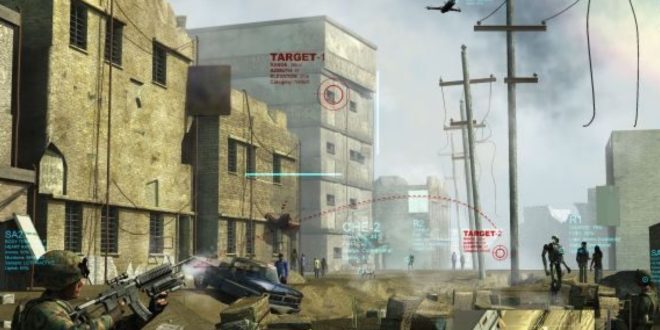An illustration of Squad X Core Technologies. (DARPA)
The Pentagon’s research and technology arm is testing a “breakthrough” AI-enabled technology for dismounted mobile combat units that synthesizes drone feeds, robot sensors, small arms fire detection, and ground-based radar — to “out cycle” enemy decision-making and attack with success.
Instead of having to gather, organize and analyze overwhelming amounts of fast-emerging combat variables, soldiers and marines can instantly access a single, integrated or “fused” product enabling them to destroy enemies “first.”
The Defense Advanced Research Projects Agency’s SQUAD X program, which is already testing with both CACI and Lockheed Martin, can take information from drone-video feeds, armed ground robots and acoustic sensors detecting the origin of incoming enemy small arms fire – and use automation to present a combined picture to squad leaders in combat.
“A Marine squad does not ever stop moving. They have a ‘bias toward action.’ We want to create a form of autonomy that also has a ‘bias toward action’ to retain the initiative. With human oversight, we employ automated engagement,” Lt. Col. Philip Root, program manager for SQUAD X, told Warrior Maven in an interview earlier this year.
HOW AI CHANGES ATTACK MISSIONS FOR US FIGHTER JETS AND BOMBERS
The system, according to Root, also draws upon ground-based radar, night-vision targeting and infrared-electro-optical sensors to inform ground units in combat. For instance, if ground-based radar were able to identify an enemy object at a certain distance, a nearby drone could be cued to gather video feeds and merge the target information with maps and other sensors, giving soldiers a complete combat picture in seconds. Among other things, this prevents soldiers from losing time analyzing overwhelming amounts of incoming data from disparate sources or nodes.
CACI’s system, according to DARPA developers, relies upon RF frequency innovations; Lockheed system involves a synthesis of sensor and targeting information.
The process can quite accurately be identified as a “ground version” of the F-35s well-known “sensor fusion” phenomenon. Through this technical process, otherwise disconnected sensor input, such as targeting, navigation and threat warning systems, are “fused” and organized into a single screen for the pilot. Referred to often as easing the “cognitive burden,” the concept is to enable informed, accurate and fast human decision making. In effect, SQUAD X does on the ground what sensor fusion does in the air. Root compared it to the historic and famous OODA loop long used to train Air Force fighter pilots. The OODA loop, defined as Observation, Orientation, Decision, Action – is intended to enable fight pilots to complete the attack process or “cycle” faster than an enemy and get inside the loop to attack and kill an enemy “first.”
“We look at how to engage in close combat with the OODA loop. In seconds or fractions of seconds we seek to use AI tools to out-cycle the adversary,” Root said.
‘FIRST-CUT-OF-STEEL’ BEGINS NEW ERA IN NUCLEAR WEAPONS, SUBMARINE WARFARE
AI-empowered computer automation can gather and process information, by itself, to complete otherwise time-consuming analysis. Human cognition, apart from computer high-speed processing, will, of course, be needed to make key, dynamic combat-relevant decisions and solve certain problems. Computer automation, fortified by AI, can use algorithms to find and synthesize key points of relevance. Perhaps information from a soldier-worn acoustic sensor identifies incoming enemy small arms fire and sends information to a drone. A nearby drone or ground robot can then glean additional information about enemy targets and, with a human decision-maker directing lethal force, launch attacks – all while soldiers and marines stay at a safe distance.
Root explained that, at times in the past, ground or air sensors have operated in a more stovepiped fashion, only able to gather information from their own sensors without benefiting from others in real time.
“We have seen ground vehicles that were just sitting in a fight because sensors did not detect that there was gunfire nearby. We want to provide a new form of sensing,” Root says.
SQUAD X testing is already demonstrating this kind of new integration, Root said, adding that simulation has enabled testers to “insert radar tracks into the system” and replicate actual combat scenarios.
NEW AIR FORCE NUCLEAR-ARMED ICBMS TO DEPLOY BY 2029
DARPA’s Tactical Technology Office documents offer additional detail into the aims and technologies central to SQUAD X. One of its key goals is described as spanning from kinetic technologies such as guns and targeting sensors – to electronic warfare and cyber domains.
SQUAD X, according to DARPA, seeks to “enable the rifle squad to precisely engage threats out to 1,000 meters, while maintaining compatibility with infantry weapon systems and human factors limitations….” and also allow non-kinetic technology to “enable the rifle squad to disrupt enemy command and control, communications, and use of unmanned assets to ranges in excess of 300 meters at a squad-relevant operational pace.”
The technology is also engineered to provide location accuracy to rifle squads within six meters in GPS-denied environments through “collaboration with unmanned systems,” DARPA information states.
SQUAD X “Precision Grenade”
While often challenged to operate in urban areas wherein walls and buildings can obstruct sensor signals, the SQUAD X system has already shown an ability to fire a first-of-its-kind “Precision grenade.” The grenade travels to a predetermined spot in the air before using a small camera to identify targets. Then, a soldier or marine can instantly look at the target information, and guide the grenade.
CLICK HERE TO GET THE FOX NEWS APP
An exact timeline for when this will be operational has yet to be determined, could likely be a few years. However, DARPA is now working closely with the Marines and Army to bring the system to the requisite level of maturity so that it can transition into a formal program of record.
More Weapons and Technology – WARRIOR MAVEN (CLICK HERE)
 Unmanned Aerial Vehicle The latest drone news
Unmanned Aerial Vehicle The latest drone news




